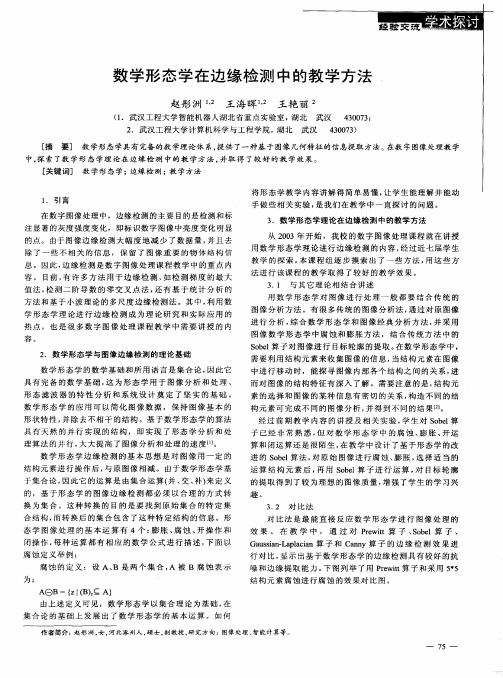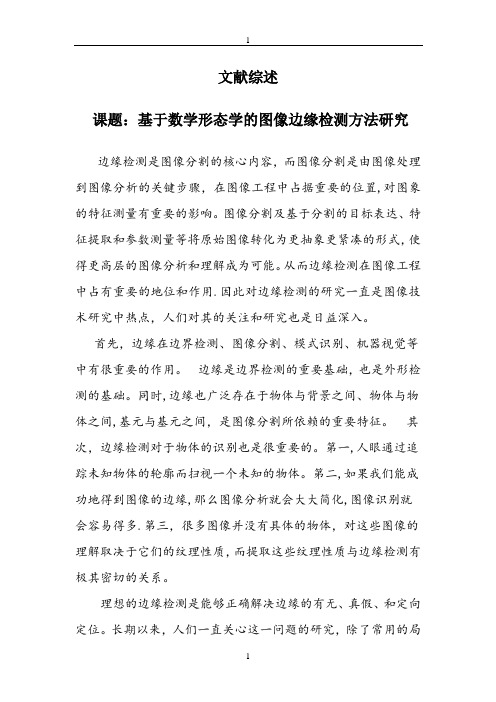基于数学形态学的图像边缘检测方法
结合边缘检测算子和形态学方法的图像边缘检测

结合边缘检测算子和形态学方法的图像边缘检测1 引言图像边缘对人的视觉有很重要的意义,一般而言,当人看一个有边缘的物体时,首先感觉到的就是边缘。
需要特别指出的是,检测出的边缘并不等于实际目标的真实边缘。
由于图像数据是二维的,而实际物体是三维的,从三维到二维的投影必然会造成信息的丢失,再加上成像过程中的光照不均和噪声等因素的影响,使得有边缘的地方不一定能被检测出来,而检测出来的边缘也不一定代表实际的边缘。
图像边缘检测,它是图像预处理与分析的重要环节之一,并广泛应用于各种领域,如目标提取与识别、遥感、图像分割、医学图像处理等。
图像的边缘是指灰度变化较为明显且剧烈(也称灰度突变)的地方,即通过灰度不连续而得到的结果,本质上也表示一个区域的结束与另外一个区域的开始。
本文列举了边缘检测从传统方法到新兴的各种方法,并对这些方法的优缺点进行了详细的分析与总结。
2 算法原理2.1 基于梯度的边缘检测算子在图像处理中,最常用的一阶导数的算法就是本节所讲的梯度算子。
梯度的等效形式是在二维平面上的一阶导数,对应的梯度算子的等效形式即为一阶导数算子。
图像边缘的强度用梯度的幅值来表示,与边缘走向垂直的方向即为梯度的方向。
梯度算子是一介导数算子,图像),(y x f 在位置),(y x 的梯度定义为下列向量:[]⎥⎥⎦⎤⎢⎢⎣⎡==∂∂∂∂xy x f y y x f f f xyy x grad ),(),(),(2222),(),(),(⎪⎪⎭⎫⎝⎛∂∂+⎪⎭⎫ ⎝⎛∂∂=+=y y x f x y x f f f y x grad yx ⎪⎪⎭⎫⎝⎛∂∂∂∂=''=x y x f y y x f f f y x),(),(arctan )arctan(22θ以上各式的偏导数需对每个像素的位置计算,实际应用中常用小区域模板进行卷积来近似计算。
对和各用一个模板,将两个结合起来就构成一个梯度算子。
根据模板的大小和元素值的不同,已提出许多不同的算子,常见的有Roberts 算子,Sober 算子, Prewitt 算子、Laplacian 算子和LoG 算子等。
数学形态学在边缘检测中的教学方法

算和 闭运算 还 是很 陌生 , 教学 中设 计 了基 于形 态学 的 改 在
进 的 S bl 法 , 原 始 图 像 进 行 腐 蚀 、 胀 , 择 适 当 的 oe 算 对 膨 选 运 算 结 构 元 素 后 , 用 S bl 子 进 行 运 算 , 目标 轮 廓 再 oe 算 对 的 提 取 得 到 了 较 为 理 想 的 图 像 质 量 , 强 了 学 生 的 学 习 兴 增
容 。
用 数 学 形 态 学对 图像 进行 处理 一 般 都 要 结 合传 统 的
图 像 分 析 方 法 。有 很 多 传 统 的 图 像 分 析 法 , 过 对 原 图 像 通
进行分析, 综合 数 学 形 态 学和 图像 经 典分 析 方 法 , 并采 用
图 像 数 学 形 态 学 中 腐 蚀 和 膨 胀 方 法 , 结 合 传 统 方 法 中 的 S b l 子 对 图 像 进 行 目标 轮 廓 的提 取 。 数 学 形 态 学 中 , oe 算 在 需 要 利 用 结 构 元 素 来 收 集 图 像 的信 息 , 结 构 元 素 在 图 像 当 中进行 移 动 时 ,能探 寻 图像 内部 各个 结构 之 间的 关系 , 进
具 有 天 然 的 并 行 实 现 的 结 构 , 即 实 现 了 形 态 学 分 析 和 处 理 算 法 的 并 行 , 大 提 高 了 图 像 分 析 和 处 理 的 速 度 …。 大 数 学 形 态 学 边 缘 检 测 的 基 本 思 想 是 对 图 像 用 一 定 的 结 构 元 素 进 行 操 作 后 , 原 图 像 相 减 。 由于 数 学 形 态 学 基 与 于 集 合 论 , 此 它 的 运 算 是 由集 合 运 算 ( 、 、 ) 定 义 因 并 交 补 来
基于数学形态学的一种改进CO2焊熔池图像边缘检测算法

基于数学形态学的一种改进CO2焊熔池图像边缘检测算法针对CO2焊熔池图像存在强烈噪声干扰,致使图像处理过程实时性和可靠性差的特点,分析总结了形态学四种基本运算的特性和六种基本形态学边缘检测算子各自的优缺点;然后结合结构元素对于图像边缘检测作用的效果和特性,组合出了一种新型算子;通过Matlab软件仿真结果证明,该算子在抗噪性方面具有较强能力,适合于CO2焊熔池图像的处理,为进一步研究焊缝跟踪问题奠定了基础。
标签:数学形态学;CO2焊;熔池;边缘检测;Matlab0 引言具有严谨的数学理论作为基础支撑的数学形态学是一门前沿学科,是一种可用于图像分析和处理的非线性理论。
这种理论方法的思想创新在于抛弃了传统的通过建立数值模型对图像进行分析的方法,从数学集合的层面来研究分析以及处理图像。
基于数学形态学的图像处理方法已经成为计算机数字图像处理领域的一个重要研究方向[1,2]。
目前焊接视觉信息控制系统主要集中于TIG焊、MIG焊、脉冲GTAW焊等焊接过程,但作为“十五”重点推广的高效率、低成本、节省能源的应用面极其广泛的CO2气保焊却少有报道[3,4]。
这是因为这种焊接方法会因为熔滴爆断和电弧燃烧产生大量金属飞溅和烟尘,且弧柱燃烧产生的烟尘也会使所获图像变得更加模糊,因此一般的图像处理方法很难应用于CO2气保焊的熔池图像处理过程[4],致使基于视觉的CO2焊焊缝跟踪技术受到严重制约。
1 数学形态学的图像处理基本运算1.1 膨胀和腐蚀设P为待处理图像,Q为结构元素,且P和Q都是由二维整数空间(R2)里的元素组成的集合。
图像P被结构元素Q膨胀,定义为:(1)膨胀是一种扩充变换,可使得整幅图像的灰度值提高,等同于对待处理区域的外部做滤波处理,作用结果是填补比结构元素尺寸稍小的小孔,并修复图像边缘存在的毛刺之间的小的凹陷区域,同时将距离小于结构元素尺寸的两物体连接起来[5]。
P用Q来腐蚀,定义如下:(2)腐蚀是一种紧缩变换,等同于对待处理区域的内部做滤波处理,该变换可以消除比结构元素尺寸小的边界点,同时起到去除比结构元素尺寸小的噪声点和填补图像内部的小孔洞的作用[5]。
基于数学形态学的边缘检测算法分析

基于数学形态学的边缘检测算法分析数学形态学是一种非常重要的图像处理技术,它可以用于形状检测、边缘提取和图像分割等图像处理任务中。
基于数学形态学的边缘检测算法可以有效地提取图像中的边缘信息,这对于图像识别和目标检测等应用非常有用。
本文将对数学形态学的原理和常用的基于数学形态学的边缘检测算法进行分析和讨论。
首先,我们来了解一下数学形态学的基本概念和原理。
数学形态学是一种基于集合论的图像处理方法,它主要研究图像中的形状和结构特征。
在数学形态学中,形态学操作是通过结构元素和图像之间的运算来实现的。
结构元素是一个小的二值图像,用于描述需要提取的目标特征。
形态学操作包括腐蚀、膨胀、开运算和闭运算等。
腐蚀操作可以用来缩小或者消除图像中的目标物体,而膨胀操作可以用来扩大或者填充图像中的目标物体。
开运算是先进行腐蚀操作,然后再进行膨胀操作,主要用于平滑和去除小的过程。
闭运算是先进行膨胀操作,然后再进行腐蚀操作,主要用于填充和封闭目标物体的空洞。
基于数学形态学的边缘检测算法是利用腐蚀和膨胀操作来提取图像中的边缘信息。
其基本思想是,在膨胀操作和腐蚀操作中,目标与背景之间的边缘处会发生改变,通过对这些改变进行分析和提取,可以得到图像中的边缘信息。
常用的基于数学形态学的边缘检测算法有基于梯度操作的边缘检测算法和基于骨架提取的边缘检测算法。
基于梯度操作的边缘检测算法主要是通过对腐蚀和膨胀操作的组合来计算图像的梯度信息。
其基本步骤包括:首先,对图像进行腐蚀操作,得到腐蚀图像;然后,对图像进行膨胀操作,得到膨胀图像;最后,计算膨胀图像和腐蚀图像之间的差异,得到图像的梯度信息。
通过梯度信息,可以得到图像中的高变化区域,即图像的边缘。
常用的基于梯度操作的边缘检测算法有Roberts算子、Sobel算子和Canny算子等。
基于骨架提取的边缘检测算法主要是通过对图像进行形态学操作,提取图像中的骨架信息来实现边缘检测。
其基本步骤包括:首先,对图像进行一系列的形态学操作,得到图像的骨架信息;然后,根据骨架信息,计算图像的边缘信息。
一种基于数学形态学的图像边缘检测方法

一种基于数学形态学的图像边缘检测方法
侯宝生
【期刊名称】《现代电子技术》
【年(卷),期】2010(033)008
【摘要】针对经典形态学方法在边缘检测时可去除图像噪声,但难以保留边缘细节的问题,提出一种能有效去除噪声且能准确检测图像边缘的方法.该方法首先利用大尺度的轮廓结构元素对图像进行滤波开、闭运算,接着用小尺度结构元素在进行经典形态学的膨胀、腐蚀运算后对图像进行梯度运算,从而得到含噪声图像的边缘信息.实验表明,该方法在准确检测图像边缘的同时,能够有效地去除图像中的噪声,且运算量相对较小.
【总页数】4页(P93-96)
【作者】侯宝生
【作者单位】陕西理工学院,陕西,汉中,723003
【正文语种】中文
【中图分类】TP391
【相关文献】
1.一种结合小波变换模极大值和灰度值数学形态学的图像边缘检测方法 [J], 郑利珍
2.一种基于数学形态学的彩色图像边缘检测方法 [J], 邢超;闫秋玲
3.一种结合数学形态学和LOG算子的遥感图像边缘检测方法 [J], 陈云波;於雪琴
4.基于小波变换与数学形态学的图像边缘检测方法 [J], 李颖莹;魏连鑫
5.一种基于数学形态学的灰度图像边缘检测方法 [J], 杨丽雯;曾朝阳;张永继
因版权原因,仅展示原文概要,查看原文内容请购买。
基于数学形态学的图像边缘检测技术_冯俊萍_航空计算技术_2004_84

基于数学形态学的图像边缘检测技术冯俊萍1,3,赵转萍1,徐 涛2(11南京航空航天大学机电学院,江苏南京210016;21南京航空航天大学信息科学与技术学院,江苏南京210016;31江苏技术师范学院机械系,江苏常州213001) 收稿日期:2004206211 作者简介:冯俊萍(1976-),女,陕西西安人,硕士研究生,主要研究方向为计算机辅助测控技术。
摘 要:边缘检测通常是用类似于素描图的图像表达出物体的要素和特征。
实际图像中,边缘由灰度突变的象素点组成,在数字图像处理和分析中具有重要的作用。
本文综合国内外最新文献资料,分析了多种基于数学形态学的边缘检测技术:基于多尺度形态学的边缘检测、基于数学形态学多极平均的图像的边缘检测、基于偏微分方程的形态学的边缘检测、基于均衡化和数学形态学的组合边缘检测、基于坐标逻辑的多结构元图像边缘检测等技术,并综合比较了其优缺点,探讨了其发展方向。
关键词:图像处理;边缘检测;数学形态学中图分类号:TP391 文献标识码:A 文章编号:16712654X (2004)0320053204引言在数字图像处理中,边缘检测的任务就是使边缘精确定位和噪声被抑制。
从数学的角度看,边缘检测是一个“病态”(Ill P osed )问题[1]。
一般说来,对检测出的边缘有以下几个要求:1)边缘的定位精度要高,不发生边缘漂移;2)对不同尺度的边缘都有良好的响应并尽量减少漏检;3)对噪声不敏感,不致因噪声造成虚假检测;4)检测灵敏度受边缘方向影响小。
通常,一个算子不可能同时满足上述要求,这就要根据实际应用情况进行权衡。
传统的边缘检测的方法基于空间运算,借助空域微分算子进行,通过将算子模板与图像进行卷积完成,根据模板的大小和元素值的不同有不同的微分算子,如:R obert 算子、Prewitt 算子、S obel 算子和K irsch 算子等,这些空域边缘检测算子对噪声都比较敏感,且常常会在检测边缘的同时加强噪声。
基于数学形态学的彩色图像边缘检测

b n lz gtec aa t i i fh os ma l sla dp p e os) o tmia n g , ya a i h rce s c o en i yn h r ts t e( i y a n ep rห้องสมุดไป่ตู้i c na n t gi e n t n e i ma
较好 地保 持 图像 边缘 细 节。
关
键
词:计算机应用;边缘检测;数 学形态学;彩 色图像
文 章 编 号 :10—182 1)604 —4 0 305 (0 0—030 1
中 图分类 号 :T 9 . P3 1 4 文献 标识 码 :A
Co o m a eEdg e e to s d o a he a i a o pho o y l rI g eD t c i n Ba e n M t m tc lM r lg
Ab t a t h r d t n le g e e to t o s h v i h s n i v t st o s ,a n v l sr c :T e ta i o a d e d t c i n me h d a e h g e st i e o n i i i i e o e c l ri a ee g e e t n ag r h b s d o t e tc l r h l g r p s d Gr y s ae o o g d e d t ci l o i m a e n mah ma ia m o t mo p o o y i p o o e . a — c l s mo p o o y i x e d d t o o a eb o tn a h p x l sav c o r h l g se t n e o c l ri g y s ri g e c i e e t ri RGB p c . d t e m a n s a e An n h
基于数学形态学的图像边缘检测方法研究文献综述

文献综述课题:基于数学形态学的图像边缘检测方法研究边缘检测是图像分割的核心内容,而图像分割是由图像处理到图像分析的关键步骤,在图像工程中占据重要的位置,对图象的特征测量有重要的影响。
图像分割及基于分割的目标表达、特征提取和参数测量等将原始图像转化为更抽象更紧凑的形式,使得更高层的图像分析和理解成为可能。
从而边缘检测在图像工程中占有重要的地位和作用.因此对边缘检测的研究一直是图像技术研究中热点,人们对其的关注和研究也是日益深入。
首先,边缘在边界检测、图像分割、模式识别、机器视觉等中有很重要的作用。
边缘是边界检测的重要基础,也是外形检测的基础。
同时,边缘也广泛存在于物体与背景之间、物体与物体之间,基元与基元之间,是图像分割所依赖的重要特征。
其次,边缘检测对于物体的识别也是很重要的。
第一,人眼通过追踪未知物体的轮廓而扫视一个未知的物体。
第二,如果我们能成功地得到图像的边缘,那么图像分析就会大大简化,图像识别就会容易得多.第三,很多图像并没有具体的物体,对这些图像的理解取决于它们的纹理性质,而提取这些纹理性质与边缘检测有极其密切的关系。
理想的边缘检测是能够正确解决边缘的有无、真假、和定向定位。
长期以来,人们一直关心这一问题的研究,除了常用的局部算子及以后在此基础上发展起来的种种改进方法外,又提出了许多新的技术,其中,比较经典的边缘检测算子有Roberts cross算子、Sobel算子、Laplacian算子、Canny算子等,近年来又有学者提出了广义模糊算子,形态学边缘算子等。
这些边缘检测的方法各有其特点,但同时也都存在着各自的局限性和不足之处。
本次研究正是在已有的算法基础上初步进行改进特别是形态学边缘算子,以期找到一个更加简单而又实用的算子,相信能对图像处理中的边缘检测方法研究以及应用有一定的参考价值。
一、课题背景和研究意义:伴随着计算机技术的高速发展,数字图像处理成为了一门新兴学科,并且在生活中的各个领域得以广泛应用。
- 1、下载文档前请自行甄别文档内容的完整性,平台不提供额外的编辑、内容补充、找答案等附加服务。
- 2、"仅部分预览"的文档,不可在线预览部分如存在完整性等问题,可反馈申请退款(可完整预览的文档不适用该条件!)。
- 3、如文档侵犯您的权益,请联系客服反馈,我们会尽快为您处理(人工客服工作时间:9:00-18:30)。
-I-
哈尔滨工业大学理学硕士学位论文
Abstract
Image edge is one of the most basic characteristics of the image, and edge detection is an important link of image pre-processing and analysis, with a wide range of theoretical and practical significance. Compared with traditional edge detection methods, image edge detection based on mathematical morphology is better, since it can change the scale of the morphological structuring element to overcome the effect of noise, and change the structure and orientation of structuring element to detect richer edges. This method can not only meet the real-time requirements, but also be easily to implemented in hardware. This paper first introduces the basic concepts and development status of mathematical morphology and edge detection, elaborates traditional edge detection methods, performs the experimental analysis of the image with and without noise, simultaneously, and then introduces some new emerging edge detection methods briefly. Since the method of edge detection in this paper is that based on mathematical morphology, we then introduce the basic theory of mathematical morphology, present some basic morphological operator formulas, and simulate in the case with and without noise and carry out a detailed analysis and summary. According to the characteristics of morphological operators and the disadvantages of selecting single structuring elements, this paper gives two improved morphological edge detection operators. The first improved operator is the formula constructed based on the characteristics of erosion, dilation, opening and closing operations to. In the images with noise, by using the open-close operation of this formula repeatedly to filter, we can effectively suppress noise. At the same time, since the selected structuring elements have the characteristic of multi-directional, this method can detect the edge information in different directions to ensure the integrity of the edge information. The second improved operator uses different structuring elements on the basis of the first improved operator, and has the characteristics of multi-structure, multi-scale and multi-direction. The multi-structuring element can detect various types of image edges, while rational combination of the multi-scale structuring element can suppress noise effectively, and simultaneously detect better edge details. Finally, this paper experiments with the two improved operators above, and compares with the previous morphological operators and traditional operators. It
国内图书分类号: O175 国际图书分类号: 519.7
学校代码: 10213 密级:公开
理学硕士学位论文
基于数学形态学的图像边缘检测方法
硕 士 研 究 生 : 曹晓琳 导 申 学 所 答 在 辩 单 日 请 学 师 : 高广宏副教授 位 : 理学硕士 科 : 计算数学 位 : 理学院数学系 期 : 2012 年 7 月
-III-
哈Байду номын сангаас滨工业大学理学硕士学位论文
目
录
摘 要 ......................................................................................................................I ABSTRACT ........................................................................................................... II 第 1 章 绪 论 ....................................................................................................... 1 1.1 引言 .............................................................................................................. 1 1.2 数字图像处理概述 ....................................................................................... 1 1.2.1 数字图像处理的发展与应用 ................................................................. 1 1.2.2 数字图像处理的主要内容 ..................................................................... 2 1.3 数学形态学概述 ........................................................................................... 3 1.3.1 数学形态学的发展状况 ........................................................................ 3 1.3.2 数学形态学在图像处理中的应用 ......................................................... 3 1.4 边缘检测概述 ............................................................................................... 4 1.4.1 图像边缘的定义 .................................................................................... 4 1.4.2 边缘检测的发展历程与趋势 ................................................................. 5 1.4.3 理想边缘检测结果的要求 ..................................................................... 6 1.4.4 边缘检测中存在的难题 ........................................................................ 6 1.5 本文的研究内容及安排 ............................................................................... 8 第 2 章 图像边缘检测的常见算法 ........................................................................ 9 2.1 基于梯度的边缘检测算子 ........................................................................... 9 2.1.1 Roberts 算子 ......................................................................................... 10 2.1.2 Sobel 算子 ............................................................................................ 11 2.1.3 Prewitt 算子 .......................................................................................... 11 2.2 基于二阶微分的边缘检测算子 .................................................................. 12 2.2.1 Laplace 算子 ......................................................................................... 13 2.2.2 LOG 算子 ............................................................................................. 13 2.2.3 Canny 算子 ........................................................................................... 14 2.3 新兴的边缘检测算法 ................................................................................. 15 2.3.1 小波分析 .............................................................................................. 15 2.3.2 模糊算法 .............................................................................................. 16 2.3.3 人工神经网络 ...................................................................................... 16 2.4 实验结果分析 ............................................................................................. 16 2.4.1 无噪声时的边缘检测结果分析 ........................................................... 16
